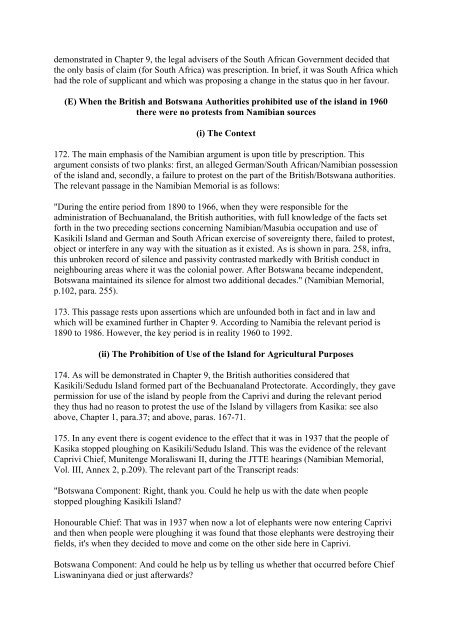botswana/namibia - Cour international de Justice
botswana/namibia - Cour international de Justice
botswana/namibia - Cour international de Justice
You also want an ePaper? Increase the reach of your titles
YUMPU automatically turns print PDFs into web optimized ePapers that Google loves.
<strong>de</strong>monstrated in Chapter 9, the legal advisers of the South African Government <strong>de</strong>ci<strong>de</strong>d that<br />
the only basis of claim (for South Africa) was prescription. In brief, it was South Africa which<br />
had the role of supplicant and which was proposing a change in the status quo in her favour.<br />
(E) When the British and Botswana Authorities prohibited use of the island in 1960<br />
there were no protests from Namibian sources<br />
(i) The Context<br />
172. The main emphasis of the Namibian argument is upon title by prescription. This<br />
argument consists of two planks: first, an alleged German/South African/Namibian possession<br />
of the island and, secondly, a failure to protest on the part of the British/Botswana authorities.<br />
The relevant passage in the Namibian Memorial is as follows:<br />
"During the entire period from 1890 to 1966, when they were responsible for the<br />
administration of Bechuanaland, the British authorities, with full knowledge of the facts set<br />
forth in the two preceding sections concerning Namibian/Masubia occupation and use of<br />
Kasikili Island and German and South African exercise of sovereignty there, failed to protest,<br />
object or interfere in any way with the situation as it existed. As is shown in para. 258, infra,<br />
this unbroken record of silence and passivity contrasted markedly with British conduct in<br />
neighbouring areas where it was the colonial power. After Botswana became in<strong>de</strong>pen<strong>de</strong>nt,<br />
Botswana maintained its silence for almost two additional <strong>de</strong>ca<strong>de</strong>s." (Namibian Memorial,<br />
p.102, para. 255).<br />
173. This passage rests upon assertions which are unfoun<strong>de</strong>d both in fact and in law and<br />
which will be examined further in Chapter 9. According to Namibia the relevant period is<br />
1890 to 1986. However, the key period is in reality 1960 to 1992.<br />
(ii) The Prohibition of Use of the Island for Agricultural Purposes<br />
174. As will be <strong>de</strong>monstrated in Chapter 9, the British authorities consi<strong>de</strong>red that<br />
Kasikili/Sedudu Island formed part of the Bechuanaland Protectorate. Accordingly, they gave<br />
permission for use of the island by people from the Caprivi and during the relevant period<br />
they thus had no reason to protest the use of the Island by villagers from Kasika: see also<br />
above, Chapter 1, para.37; and above, paras. 167-71.<br />
175. In any event there is cogent evi<strong>de</strong>nce to the effect that it was in 1937 that the people of<br />
Kasika stopped ploughing on Kasikili/Sedudu Island. This was the evi<strong>de</strong>nce of the relevant<br />
Caprivi Chief, Munitenge Moraliswani II, during the JTTE hearings (Namibian Memorial,<br />
Vol. III, Annex 2, p.209). The relevant part of the Transcript reads:<br />
"Botswana Component: Right, thank you. Could he help us with the date when people<br />
stopped ploughing Kasikili Island?<br />
Honourable Chief: That was in 1937 when now a lot of elephants were now entering Caprivi<br />
and then when people were ploughing it was found that those elephants were <strong>de</strong>stroying their<br />
fields, it's when they <strong>de</strong>ci<strong>de</strong>d to move and come on the other si<strong>de</strong> here in Caprivi.<br />
Botswana Component: And could he help us by telling us whether that occurred before Chief<br />
Liswaninyana died or just afterwards?

















